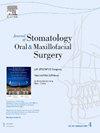Machine learning-assisted diagnosis of parotid tumor by using contrast-enhanced CT imaging features
IF 1.8
3区 医学
Q2 DENTISTRY, ORAL SURGERY & MEDICINE
Journal of Stomatology Oral and Maxillofacial Surgery
Pub Date : 2025-02-01
DOI:10.1016/j.jormas.2024.102030
引用次数: 0
Abstract
Purpose
This study aims to develop a machine learning diagnostic model for parotid gland tumors based on preoperative contrast-enhanced CT imaging features to assist in clinical decision-making.
Materials and methods
Clinical data and contrast-enhanced CT images of 144 patients with parotid gland tumors from the Peking University School of Stomatology Hospital, collected from January 2019 to December 2022, were gathered. The 3D slicer software was utilized to accurately annotate the tumor regions, followed by exploring the correlation between multiple preoperative contrast-enhanced CT imaging features and the benign or malignant nature of the tumor, as well as the type of benign tumor. A prediction model was constructed using the k-nearest neighbors (KNN) algorithm.
Results
Through feature selection, four key features—morphology, adjacent structure invasion, boundary, and suspicious cervical lymph node metastasis—were identified as crucial in preoperative discrimination between benign and malignant tumors. The KNN prediction model achieved an accuracy rate of 94.44 %. Additionally, six features including arterial phase CT value, age, delayed phase CT value, pre-contrast CT value, venous phase CT value, and gender, were also significant in the classification of benign tumors, with a KNN prediction model accuracy of 95.24 %.
Conclusion
The machine learning model based on preoperative contrast-enhanced CT imaging features can effectively discriminate between benign and malignant parotid gland tumors and classify benign tumors, providing valuable reference information for clinicians.

利用对比增强 CT 成像特征的机器学习辅助诊断腮腺肿瘤。
目的:本研究旨在开发一种基于术前对比增强CT成像特征的腮腺肿瘤机器学习诊断模型,以辅助临床决策:收集2019年1月至2022年12月北京大学口腔医学院附属医院144例腮腺肿瘤患者的临床资料和对比增强CT图像。利用三维切片软件对肿瘤区域进行精确标注,然后探讨术前多种对比增强CT成像特征与肿瘤良恶性以及良性肿瘤类型之间的相关性。结果:通过特征选择,确定了四个关键特征--形态、邻近结构侵犯、边界和可疑宫颈淋巴结转移--是术前区分良性肿瘤和恶性肿瘤的关键特征。KNN 预测模型的准确率达到 94.44%。此外,动脉期CT值、年龄、延迟期CT值、对比前CT值、静脉期CT值和性别等6个特征在良性肿瘤的分类中也具有重要意义,KNN预测模型的准确率为95.24%:基于术前对比增强CT成像特征的机器学习模型能有效区分腮腺肿瘤的良恶性,并对良性肿瘤进行分类,为临床医生提供有价值的参考信息。
本文章由计算机程序翻译,如有差异,请以英文原文为准。
求助全文
约1分钟内获得全文
求助全文
来源期刊

Journal of Stomatology Oral and Maxillofacial Surgery
Surgery, Dentistry, Oral Surgery and Medicine, Otorhinolaryngology and Facial Plastic Surgery
CiteScore
2.30
自引率
9.10%
发文量
0
审稿时长
23 days
 求助内容:
求助内容: 应助结果提醒方式:
应助结果提醒方式:


